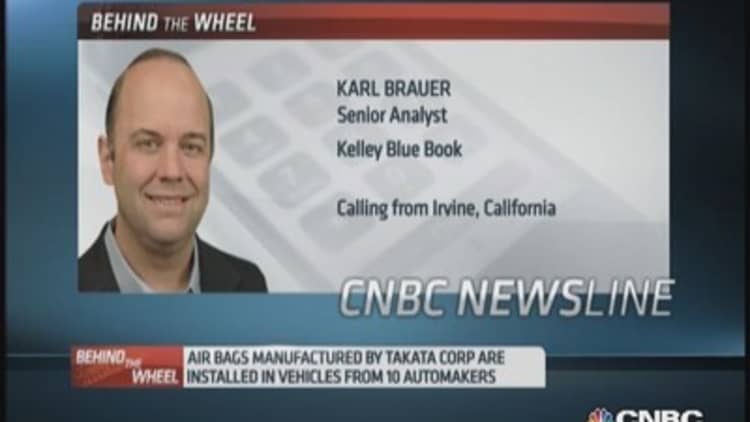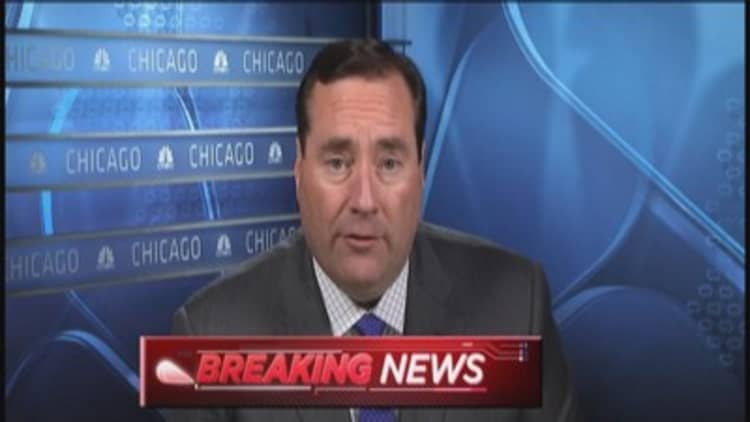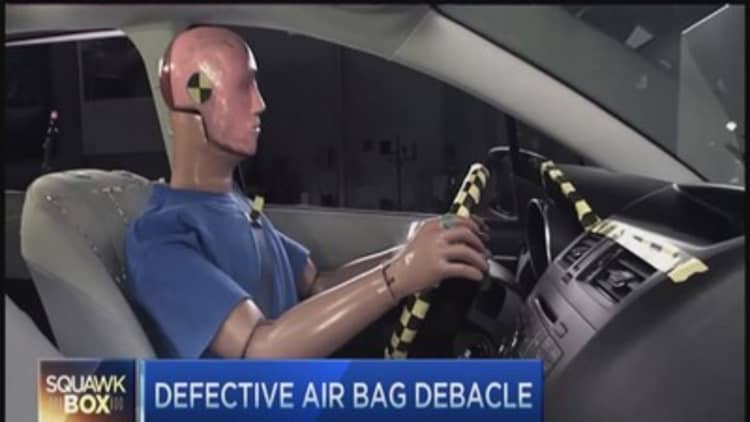Alarmed by a report a decade ago that one of its airbags had ruptured and spewed metal debris at a driver in Alabama, the Japanese manufacturer Takata secretly conducted tests on 50 airbags it retrieved from scrapyards, according to two former employees involved in the tests, one of whom was a senior member of its testing lab.
The steel inflaters in two of the airbags cracked during the tests, a condition that can lead to rupture, the former employees said. The result was so startling that engineers began designing possible fixes in preparation for a recall, the former employees said.
But instead of alerting federal safety regulators to the possible danger, Takata executives discounted the results and ordered the lab technicians to delete the testing data from their computers and dispose of the airbag inflaters in the trash, they said.
Read More
The secret tests, which have not been previously disclosed, were performed after normal work hours and on weekends and holidays during summer 2004 at Takata's American headquarters in Auburn Hills, Mich., the former employees said.
That was four years before Takata, in regulatory filings, says that it first tested the problematic airbags. The results from the later tests led to the first recall over airbag rupture risks in November 2008.
Today, 11 automakers have recalled more than 14 million vehicles worldwide because of the rupture risks. Four deaths have been tied to the defect, which can cause the airbag's steel canister to crack and explode into pieces when the device deploys in a crash. The airbags are inflated by means of a propellant, based on a common compound used in fertilizer, that is encased in the canister, which together are known as the inflater.
Complaints received by regulators about various automakers blame Takata airbags for at least 139 injuries, including 37 people who reported airbags that ruptured or spewed metal or chemicals. Takata is one of the world's largest suppliers of airbags, accounting for about one-fifth of the global market.
The former Takata employees, who between them had four decades of experience at the company, spoke on the condition of anonymity because of continuing ties to Takata. They said they were speaking up because of concerns that their former employer was not being forthright about the defective airbags.
"All the testing was hush-hush," one former employee said. "Then one day, it was, 'Pack it all up, shut the whole thing down.' It was not standard procedure."
A spokesman for Takata, Alby Berman, declined to comment on the disclosure of the testing.
Read MoreNot liable for pre-bankruptcy claims: GM
In the past, a spokesman for Honda said it was assured by Takata in 2004 that the episode in Alabama, which involved a 2002 Honda Accord, was an anomaly.
On Thursday, a Honda spokesman, Chris Martin, said in a statement, "This is a serious allegation about actions taken by Takata. It is our intention to determine whether anyone at Honda has any evidence that these claims are credible."

Separately, materials reviewed by The New York Times cast doubt on Takata's claims to federal regulators that it had resolved manufacturing and quality control problems with its airbag propellant in the early 2000s. Takata has said, in regulatory filings, that by November 2002, it had ensured that there was "proper handling" of the propellants at a factory in Moses Lake, Wash., where it had traced problems with the rupturing airbags.
But as recently as April 2009, Takata engineers scrambled to repair a flaw in a machine at another factory in Monclova, Mexico, that made the airbag propellant more volatile, according to materials from a company presentation given that year.
Two former quality-control managers at the company's main distribution center in Texas, moreover, described in interviews a series of quality problems that arose as the company raced to meet a surge in demand for its airbags.
The Times reviewed internal Takata documents, emails, photos, videos and regulatory filings. Emails show workers raising concerns that airbag units were being delivered to automakers wet or damaged because of transportation mishaps. Closed-circuit television footage shows forklifts dropping stacks of the airbag units.
The dropped airbags were not always properly inspected for damage, especially in the early 2000s, according to the former quality-control managers who said they later pushed for stricter controls at the facility. The two spoke on the condition of anonymity because of fear of retribution.
Takata is facing renewed scrutiny for its handling of the defective airbags, which The Times reported in September had been the subject of a short-lived investigation by the National Highway Traffic Safety Administration that was closed in 2010 without any enforcement action. The federal agency has now reopened its investigation into Takata, a House committee has asked the Government Accountability Office to conduct its own investigation, and federal prosecutors in Manhattan have also taken an interest.

"Claims such as these have raised additional concerns about Takata's handling of airbag issues and are one of the reasons we're compelling them to produce documents and answer questions, under oath," the highway safety agency said.
"Takata will continue to fully cooperate with the government investigation as we also support the needs of our customers," Mr. Berman, the spokesman, said.
Read MoreUncertainty to push Takata to wider loss
In Tokyo on Thursday, the company's chief financial officer apologized broadly for the problems caused by the defective airbags, while the company announced that legal uncertainty and rising recall costs would result in a larger-than-expected quarterly loss.
"We don't know at this point how things will play out," said Yoichiro Nomura, the chief financial officer.
The most recent death linked to the airbags involved an accident in a suburban Los Angeles parking lot last year. Hai Ming Xu, 47, was killed by an airbag that deployed explosively in his 2002 Acura TL.
The police in Alhambra, Calif., initially treated the case as a homicide because of the nature of his injuries, before an autopsy suggested the wounds were caused by the airbag, according to a Los Angeles County Coroner's report. The report concluded that extensive lacerations on Mr. Xu's face came from "a metallic portion" of the airbag inflater that "hit the deceased on the face as it deployed." The report also said tears had been discovered in the airbag.
The first known rupture of a Takata airbag occurred in Alabama in 2004, according to Honda. The inflater that ruptured in the Accord and injured the car's driver that year "looked like it had exploded, and had a hole punched out of the side of the canister," said one of the former Takata lab employees who examined the airbag.
Takata and Honda have declined to disclose further details of that accident, which ended in a settlement between the automaker and the driver, according to Honda.
Behind the scenes, however, the former Takata lab employees said, the manufacturer wanted to know more. The tests on the 50 airbags were supervised by Al Bernat, then Takata's vice president for engineering, they said, and were unknown to all but a small group of people, that included lab technicians, fabricators and engineers. The employees said that they did not know under whose authority Mr. Bernat was operating.
The tests' results worried the technicians: Two of the airbag inflaters Takata had retrieved from the junkyards showed cracks and the start of "rapid disassembly" during the tests, Takata's preferred term for explosion, according to the two people. They said Takata engineers at the time theorized that a problem with the welding of the inflater's canister, intended to hold the airbag's explosives, made its structure vulnerable to splitting and rupturing. The two people said engineers designed prototypes for possible fixes, including a second canister to strengthen the unit.
But after three months, they said, the testing was ordered halted. The lab employees were also instructed that all data, including video and computer backups, be destroyed. Inflaters and prototypes of fixes were also to be disassembled and disposed of in a scrap-metal Dumpster, the senior lab employee said. No explanation was offered, the employee said, though the order was not considered surprising given the secret nature of the testing.
Read MoreAudi recalls nearly 102,000 vehicles to fix air bag
As for the two problematic airbag inflaters, Mr. Bernat, the supervisor, told people at the time that they were not significant because they had been retrieved from cars with cracked windshields and were likely "corrupted by weather," according to the two former employees.
Reached at his home in Rochester Hills, Mich., Mr. Bernat declined to comment and referred questions to his former employer. Takata also declined to comment.
As automakers have recalled the airbags in recent years, Takata has suggested that weather plays a significant role in making its airbags prone to rupture. Takata said humidity could hurt the stability of the airbag's explosives.
In explaining the efect, the company has also pointed to manufacturing flaws involving the airbags' explosive, or propellant, including improper exposure to moisture, and problems with a machine that presses propellant powder into tablets. Takata has said both troubles were corrected in the early 2000s.
But the internal documents suggest Takata engineers scrambled as late as 2009 to repair a machine at its Monclova plant that pressed explosive propellant powder into pellets after "inflaters tested from multiple propellant lots showed aggressive ballistics," according to the internal presentation in June 2009.
The internal materials and interviews with the former quality-control managers also suggest that quality control problems at Takata stretched beyond its production lines.
Airbag modules would get wet during transit, arriving wet at automakers' assembly plants on leaky trucks, the managers said. The problems were addressed in an overhaul of operations at the plant starting in 2004, but local managers struggled to maintain the stricter controls.

"The whole situation makes me sick," one manager wrote in a February 2007 email addressed to multiple colleagues in which he complained that checks the center had introduced to try to keep the airbags dry — including hosing down trucks to check for leaks — were being ignored.
A 2009 presentation of guidelines on handling inflaters and airbag units stressed the dangers of mishandling them. The presentation included a link to a video that appeared to show side-curtain airbags deploying violently, sending the inflater hurtling into the car's cabin. (The inflater does not rupture in that video.)
And in an email, dated October 2005, a second manager urged employees to examine the propellant visible in a cross section of an airbag inflater. "The propellant arrangement inside is what can be damaged when the airbags are dropped," that manager wrote. "Here you can see why it is important to handle our product properly."
Still, even after stricter controls were introduced at the distribution center, Takata's production facilities would resist taking back possibly damaged or wet airbag modules, according to the two managers. One reason, they said, was that Takata struggled to keep up with a surge in demand for its airbags through the early and mid-2000s as it won big new clients like General Motors.
And as automakers drove down costs using "just-in-time" production — which require parts to arrive at assembly plants only as they are required — Takata was under pressure to meet intense delivery schedules, they said. Workers were often told that if a client like Honda or Toyota was required to stop production at their plants because of a late Takata shipment, the parts supplier would be fined tens of thousands of dollars for every minute of lost production.
"That put a lot of pressure and incentive on us to never miss a shipment," said one of the former managers. "I'd argue, 'what if my daughter bought the car with the bad airbag?' But the plant would tell us, 'Just ship it.' "


